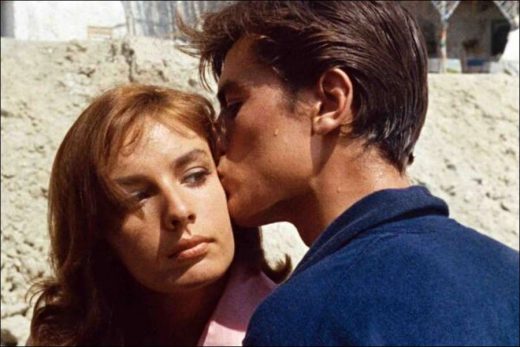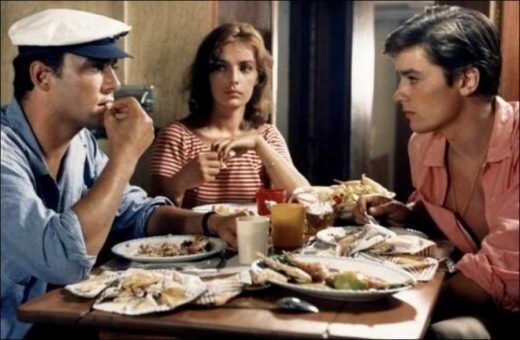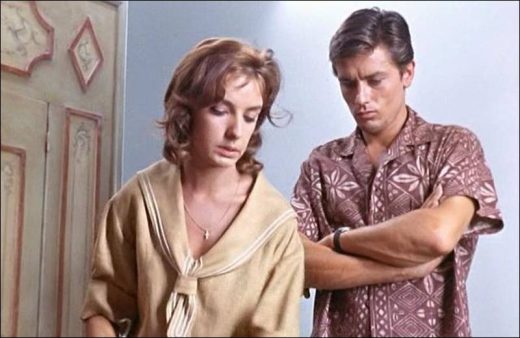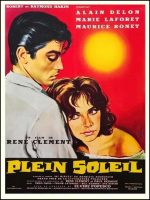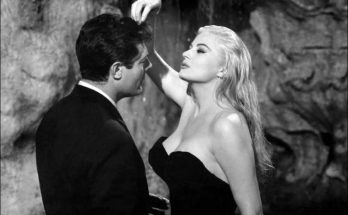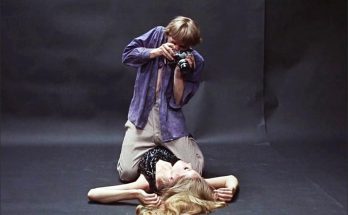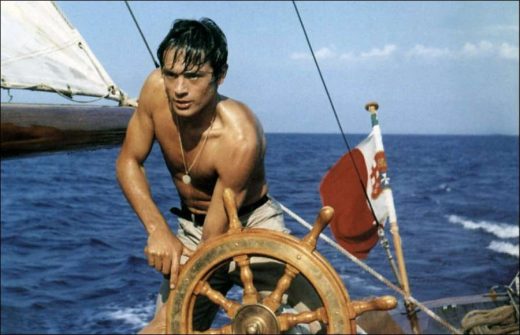
Plein Soleil (Purple Noon in English), directed by René Clément, adapted from Patricia Highsmith’s ‘The Talented Mr. Ripley’ and starring Alain Delon, tells the story of Tom Ripley, an angel-faced devil who gets away with all the evil he has done. The film, which gained a completely different dimension with the music of Italian composer Nino Rota, also bears traces of the French New Wave and Italian Neorealism movements.
1960 is an interesting year for the history of cinema. When we look at the production years of many landmark films, we see this date. Psycho (Hitchcock), which is considered the first modern American film and created a significant breakthrough in the horror genre and started slashers; The Virgin Spring (Jungfrukällan) (Bergman), which focused on the theme of revenge and started another horror subgenre open to exploitation; French New York.
For example, Vagrant Lovers (À bout de souffle) (Godard), in which we met Wave’s first great anti-hero, was made in 1960. So are classics such as Peeping Tom (Powell), The Apartment (Wilder), Faceless Eyes (Les yeux sans visage) (Franju), Spartacus (Kubrick). And three iconic examples of Italian cinema, Rocco and His Brothers (Rocco e i suoi fratelli) (Visconti), L’Avventura (Antonioni), La Dolce Vita (Fellini), are among this year’s films.
The subject of this article is Plein Soleil, another relatively less famous classic, which was released in 1960. Angry Sun also opens on Rome’s Via Veneto Street, immortalized in Fellini’s La Dolce Vita. And just like in La Dolce Vita, it gains another dimension when combined with the penetrating music of the great composer Nino Rota.
We can start talking about this René Clément film, which is freely adapted from Patricia Highsmith’s 5-novel Ripley series, ‘The Talented Mr. Ripley’ (1955), with the dark hero of the story. From Tom Ripley, an angel-faced, devil-haired sociopath who gets away with all the evil he has done and is a master of getting away with it. Tom is very handsome, very scary, very talented. He has ten skills on ten fingers: forgery of documents, forging signatures, manipulation, theft, murder. And he knows no bounds when it comes to showing off his skills.
It all starts when Tom comes to Rome from America for a special mission given to him. What we have before us is different from the stories of agents, private detectives and undercover cops who have to carry out a difficult mission, the most famous of which is the Mission Impossible series and of which there are countless examples. Instead of doing his duty, Tom Ripley charts a new path for himself by pursuing his ambitions and obsessions.
In other words, the film has an alternative story logic. In the classical structure, the path to be followed is clear and the issue of conflict is the difficulty of achieving it. Here, however, it is the uncertainty of the road that creates conflict and differentiates the navigation experience. This ambiguity does not arise from the hero’s reticence. He doesn’t know his next step either. It is not clear from left to right. It is unreliable. He is indifferent to the pain and happiness of those he encounters.
Plein Soleil, despite its story full of crime and evil, is full of sunny scenes, heartwarming pastel tones, and wide-ranging landscapes. Especially the first episode flows like a Tintin adventure. In the film, which is a French-Italian co-production, the influences of French New Wave and Italian Neorealism can be seen together.
Although it differs greatly from the productions of these two periods in terms of its subject, genre and general tone, traces of Italian Neorealism can be felt during Tom’s wandering in the fish market, and French New Wave influences can be felt in the unusual flow of the episodes on the yacht. Of course, René Clément’s skill in not only conveying the story but also adding a visual layer and a brilliant idea to it at every stage is not limited to these sections.
Let’s explain a little bit about what this special mission is and what the hero does instead. Tom Ripley’s mission is to ensure that his childhood friend, rich playboy Philippe Greenleaf, whom he has not seen for five years, returns to San Francisco and takes over the family business. In return, he will receive five thousand dollars. However, when he finds his friend, he sees that he has no intention of returning to the USA.
After their wanderings on the streets of Rome, they go to Philippe’s house together. The young man lives here with his fiancée Marge. The scene where Tom wears Philippe’s clothes and kisses him in the mirror in this house is so ridiculous and funny at first watch. However, if you remember it after the movie is over, it is a chilling and eerie scene that summarizes everything. Hidden within this brief moment is Tom’s intense interest in both Philippe, Philippe’s girlfriend Marge, and Philippe’s fortune.
Tom continues to sneak up on the young couple and sneak into his friend’s life. Together they move to Philippe’s luxury yacht named Marge. After a while, Philippe gets tired of Tom’s constant eyes on him, as he cannot tell whether he is looking at him friendly or hostile. He begins to treat her like a dog, even tormenting her. The last straw is that he drags Tom with the small boat at the end of the rope tied to the yacht and leaves him to roast under the hot sun for hours.
Returning to the yacht, Tom plans to kill Philippe and take his place. With a simple trick, he leaves the earring he had put in his pocket during the trip in Rome where Marge will find it, causing the woman to have a fit of jealousy and leave the yacht. The two men are now alone. Tom has found where Philippe keeps his bank papers and challenges him by revealing his plan.
One of the most unusual points of the story is that Tom speaks openly to the other person at every stage. When they first meet, he tells him what his mission is and the amount of money he will receive in return, and then he tells him that he will kill him and forge his signature to put the money in the bank. At the end of this tense flow, which proceeds in a half-joking, half-serious atmosphere, Tom shows how serious he is. He throws Philippe’s lifeless body tied to the rope into the sea and cuts off the end of the rope. The sea suddenly swells and the waves get stronger. Tom sets sail for a new life to transform into someone else.
Finally landing on land, Tom tells Marge that Philippe has left him and returns to his hotel in Rome. He pastes his own picture on the passport of the man he killed and becomes an expert at forging his signature. He has Philippe’s money in his bag, which he took from the bank, his shirt with Philippe embroidery on it, the dead man’s shoes on his feet, and his passport with his photo changed in his pocket. However, this is not as simple as one man taking the place of another. Tom becomes himself and Philippe. He jumps from one identity to another through strategic maneuvers.
As it is known, one murder always leads to another. Tom is also forced to kill Philippe’s friend Freddie, who finds him while looking for Philippe. Since he is now Philippe, the murderer is also Philippe. And he prepares a will and a suicide note in the name of the deceased, whom he blames for the murder. He donates the young man’s entire fortune to Marge. The next move is obvious: make Marge fall in love with him. Mr. Ripley is also skilled at stealing hearts.
The Italian police have been on Tom’s neck since the beginning, but he never gives up. Until the moment Philippe’s yacht was pulled ashore for the sales process. Immediately after the murder, the rope thrown into the sea was tangled in the propeller of the yacht, and the body he was dragging was revealed. Tom destroyed all the clues, but in the end Philippe’s decomposed body appeared at the end of a rope. It’s all over for Tom. However, the movie ends with a scene in which the Talented Mr. Ripley, unaware of this, is smiling.
Identity change is a special category that we frequently encounter in cinema. Examples range from Charlie Chaplin’s The Great Dictator (1940) to face transplant films, which were the fetish theme of a period, and narratives of the main character going crazy slowly transforming into someone else he is obsessed with. As in Angry Sun, the stories on which the entire flow is based are more limited. I would like to mention two of whom I find close.
Al, the hero of Detour (1945), a low-budget film noir, travels by hitchhiking. And he becomes friends with Charlie, who takes him in his car. Everything is fine until Charlie’s unprovoked death. Panicked, Al hurriedly takes Charlie’s place, fearing that he will face death. He puts on the dead man’s jacket and puts his driver’s license in his pocket so that it matches the luxury vehicle he is driving and does not arouse suspicion. He leaves the body on the side of the road and continues on his way with his new identity. And the woman who will stand in his way is the dead man’s wife. As in Angry Sun, a love triangle has been established in which one of them is dead.
A more existential “story of continuing with the dead man’s identity”, where the sun is even hotter, is The Passenger (Professione: Reporter, 1975). Journalist David Locke goes to North Africa to follow news of a guerrilla war. He settles in a hotel near the Sahara Desert. When the man she met here, who was staying in the next room and looked very similar to her, dies, she decides to escape from her monotonous life and take his place. He informs the reception of his own death and puts the dead man’s passport in his pocket. However, David Locke is not as talented as Mr. Ripley.
All about Plein Soleil (Purple Noon) movie.
Plein Soleil (1960)
Purple Noon
Directed by: René Clément
Starring: Alain Delon, Maurice Ronet, Marie Laforêt, Erno Crisa, Billy Kearns, Elvire Popesco, Nicolas Petrov, Ave Ninchi, Lily Romanelli, Nerio Bernardi, Viviane Chantel, Paul Muller, René Clément, Romy Schneider
Screenplay by: René Clément, Paul Gégauff
Production Design by: Paul Bertrand
Cinematography by: Henri Decaë
Film Editing by: Françoise Javet
Costume Design by: Bella Clément
Makeup Department: Louis Bonnemaison
Music by: Nino Rota
MPAA Rating: PG-13 for momentary violence and sexuality.
Distributed by: CCFC (France), Titanus (Italy)
Release Date: March 10, 1960 (France), September 2, 1960 (Italy)
Views: 195
